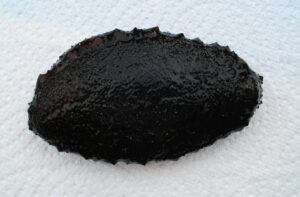Brown Sea Cucumber, Isostichopus fuscus



 Brown Sea Cucumber, Isostichopus fuscus. Tidal pool collections made in the greater Los Cabos area of Baja California Sur. Lengths between 7.5 cm (3.0 inches) and 15 cm (5.9 inches).
Brown Sea Cucumber, Isostichopus fuscus. Tidal pool collections made in the greater Los Cabos area of Baja California Sur. Lengths between 7.5 cm (3.0 inches) and 15 cm (5.9 inches).
 Brown Sea Cucumber, Isostichopus fuscus. Underwater photograph taken in Zihuatanejo Bay, Guerrero, March 2018. Photograph courtesy of Ron Woheau, Zihuatanejo.
Brown Sea Cucumber, Isostichopus fuscus. Underwater photograph taken in Zihuatanejo Bay, Guerrero, March 2018. Photograph courtesy of Ron Woheau, Zihuatanejo.
Phylogeny: The Brown Sea Cucumber, Isostichopus fuscus (Ludwig, 1875) is a member of the Spiky Sea Cucumber or Stichopodiidea Family. They are also known as the Giant Cortez Sea Cucumber and the Chocolate Sea Cucumber, and in Mexico as pepino de mar café and pepino de mar pardo.
Morphology: The Brown Sea Cucumber is a uniform brown color or mottled dark brown over a tan background. Their bodies are large with a flattened ventral surface, a square or angular cross section, and 20 mouth tentacles. Their skin is leathery and smooth to the touch. Dorsally they are covered with cone shaped projections and 20 blunt papillae arranged in rows. Brown Sea Cucumbers reach a maximum of 16.2 cm (6.5 inches) in length and between 300 grams (0.67 lbs) and 1 kg (2.2 lbs) in weight. Two cases of albinism have been discovered in this species, one found in Loreto, Baja California Sur and another found in Bahiá de Los Angeles, Baja California.
Habitat and Distribution: The Brown Sea Cucumber resides within rocks and sand substrate and occasionally in mud and are found in tidal pools from the intertidal zone to depths up to 43 m (140 feet). They are generally found in more protected areas, where water movement will not sweep their food away. The Brown Sea Cucumber is a resident of all Mexican waters of the Pacific Ocean, except they are not found along the West Coast of the Baja Peninsula.
Diet: The Brown Sea Cucumber is a depositional feeder that crawl along the bottom, using their sticky tentacles to collect detritus and other organic matter, such as bacteria and fungus. This method of feeding redistributes sediment, and therefore contributes to the general ecology. Some members of the family have an annual cycle of auto-eviscerating their digestive tract and gonads to remove sediment from their digestive tracts that have been accumulated from their feeding process.
Predators: The Brown Sea Cucumber is preyed upon by fish, marine mammals, and starfish. They do have the ability to auto-eviscerate their internal organs to distract potential predators. They have the ability to regrow these organs in a matter of weeks.
Reproduction: Brown Sea Cucumbers reproduce sexually via external fertilization. The larvae are free-swimming until they settle to the bottom and become benthic. This species exhibits no sexual dimorphism unless the gonads are ripe. When this occurs the male gonads are white in color and the females are orange.
Endangerment Status: The Brown Sea Cucumber is currently considered to be ENDANGERED due to overfishing. They are sold commercially as Beche-de-mer and are in high demand in Asian countries. Populations are thought to have declined by as much as 60% over the last fifty years. They are now heavily regulated but without adequate enforcement, populations have been exceedingly slow to recover. Beche-de-mer is currently available on the internet in a sun-dried format at $100 per pound. Efforts to reestablish native populations via aquaculture have had marginal results.
Synonyms: Stichopus fuscus, Stichopus badionotus.